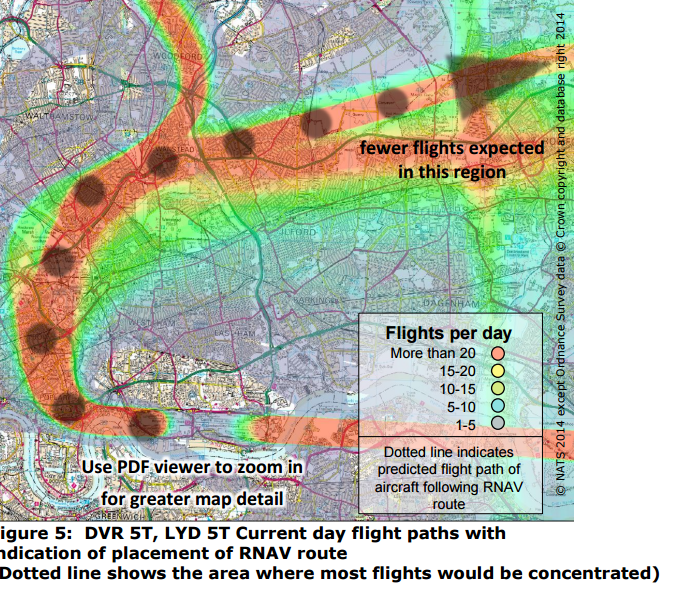HACAN East meets CAA to thrash out noise problems caused by newly concentrated routes
John Stewart and Rob Barnstone from HACAN East at London City Airport had a 2 hour meeting with the five members of the CAA, to discuss the new concentrated flight paths-causing intensified noise. The CAA is aware of the unhappiness amongst communities and local authorities at their decision to allow flight path changes in February 2016. One of the most unpopular changes is concentration of the departures route, in westerly winds, that takes off towards the west and turns north and east. The other change is for arrivals, in easterly winds, when planes approach from east, south of the airport. Most of these communities are also overflown by Heathrow planes on the days there is a westerly wind. Both these have led to intensified noise for thousands of people. London City Airport had argued that they could get away with minimal consultation on these changes because the changes were “not significant.” However, there has been a definite change since February. HACAN East pointed out that the CAA that there was no mechanism to look at changes over time. There were many changes made in 2008 when the flight paths were changed to accommodate the larger planes which needed to make a much wider turn. HACAN East stressed that respite was important to local communities. People are encouraged to contact the CAA and the airport, to express their views on the noise issue.
.
Tweet
Meeting with the Civil Aviation Authority
Our Chair, John Stewart and Campaign Co-Ordinator Rob Barnstone met the Civil Aviation Authority (CAA) on Wednesday [15th June] to discuss the concentrated flight paths at London City Airport.
The CAA fielded at team of five and gave us nearly 2 hours.
They are aware of the unhappiness amongst communities and local authorities at their decision to allow City Airport to concentrate its flight paths in February 2016.
They listened to what we had to say. We outlined the problems:
Things had changed noticeably for many communities in East and NE London.
City Airport had argued that they could get away with minimal consultation because the changes they were making were not significant as many of the planes were already flying something approaching concentrated routes. We pointed out that many people had noticed a real difference since February.
We also pointed out that the CAA seemed to have no mechanism to look at changes over time. The only reason City Airport could even begin to argue during the consultation that some of the changes proposed were not significant (for example, departures over Leyton, Leytonstone and Wansted areas) was because “significant changes” had been made in 2008 when the flight paths were changed to accommodate the larger planes which needed to make a much wider turn when leaving the airport.
The smaller ‘turbo-prop’ planes made a sharp turn when taking off, barely flying over many of the areas that now are under a concentrated flight path. The CAA seemed to accept our point that there was no organisation responsible for assessing the changes over time.
THIS MAP SHOWS THE CURRENT CONCENTRATED FLIGHT PATHS ACROSS NORTH-EAST LONDON for departures when there is a westerly wind, so planes take off towards the west.
We also outlined what the February changes meant for South London.
We stressed that respite was important to local communities.
The CAA outlined what happens next:
It became clear that pressure needs to be put on the airport by communities and local authorities to consider changes.
City Airport is keen on the concentrated routes because they make it easier to guide planes when landing and taking off. NATS also like them because the new computer technology in the planes means that air traffic controllers are much less involved in guiding the them, thus saving NATS time and money.
What do we do next?
HACAN East will:
– Lobby City Airport to abandon its current plan to concentrate all its flight paths over particular communities and instead to introduce respite so people an get some relief from the noise
– Bring together a cross-party group of politicians to assist in this lobbying
– Organise a series of public meetings to inform local communities about the latest development
– Encourage local people to email and write to the airport and the CAA.
What you can do:
(1). London City Airport: James Shearman, Environment Manager at:
London City Airport, City Aviation House, Royal Docks, London E16 2PB
Email: environment@londoncityairport.com
Or call +44 (0)207 646 0200
.
(2). Civil Aviation Authority (CAA) – information or complaints concerning flight paths:
Directorate of Airspace Policy, K6 G7, CAA House, 45-59 Kingsway, London WC2B 6TE
Email: aree@caa.co.uk
Please include info@hacaneast.org.uk in your emails to one of the above organisations, as it helps us build an even broader picture of your thoughts and feelings on the issue.


